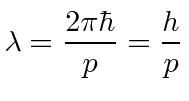Next: Computing DeBroglie Wavelengths Up: Diffraction Previous: Diffraction from Crystals Contents
DeBroglie applied this Lorentz invariance requirement on the phase of matter waves to determine
what the wavelength must be.
Its easy for us to derive the wavelength using 4-vectors.
Position and time form one 4-vector.


Recall that Lorentz vectors must be transformed but
Lorentz scalars are automatically invariant under transformations.
For example the scalar formed by dotting the 4-momentum into itself is

To compute the wavelength for our matter waves, lets use the scalar

To read off the wavelength, lets pick off the part of the expression that corresponds
to
![]() .
We see that
.
We see that
 and therefore the DeBroglie wavelength is.
and therefore the DeBroglie wavelength is.
 |
We can also read off the frequency
![]() .
.

The deBroglie wavelength will be our primary physics input for the development of Quantum Mechanics. Its not that this work was the most significant, but, this wavelength summarizes most of what happened before 1923.